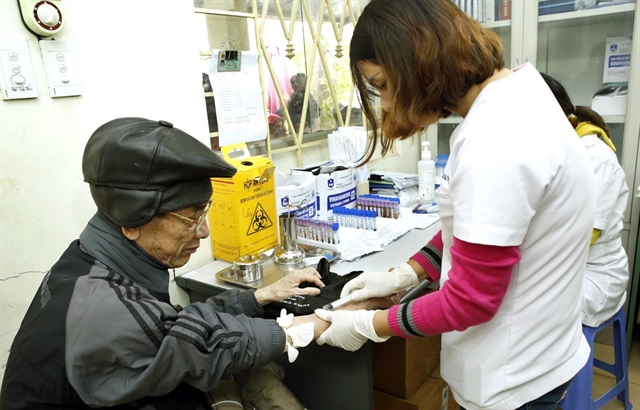 Society
Society

HIV/AIDS remains an important public health problem in Việt Nam with nearly 10,000 new HIV infections and 2,000 people killed by AIDS each year, participants heard on Wednesday at a conference on 20 years treatment of HIV/AIDS in Việt Nam.

|
| A health worker collects a blood sample from a people with HIV in Hà Nội. — VNA/VNS Photo Dương Ngọc |
HÀ NỘI — HIV/AIDS remains an important public health problem in Việt Nam with nearly 10,000 new HIV infections and 2,000 people killed by AIDS each year, participants heard on Wednesday at a conference on 20 years treatment of HIV/AIDS in Việt Nam.
“This is an immeasurable danger that not only impacts health, but also the stability of society," said Deputy Minister of Health Trương Quốc Cường at the event.
Cường said that Việt Nam still faced many challenges in ending the HIV/AIDS epidemic by 2030 due to people’s awareness about the benefits and effectiveness of ARV treatment is limited and stigma remains a major barrier to early access to treatment.
“There are many difficulties in access to people living with HIV in high-risk groups while the domestic market for ARV drug supply remains small, making difficulties in providing continuous drugs, especially medicine for children,” said Cường.
“International aid budgets are declining rapidly while payments for HIV/AIDS treatment services from the newly implemented Health Insurance Fund requires more time to operate properly.”
The Việt Nam Administration of HIV/AIDS Control (VAAC) under the Ministry of Health director Nguyễn Hoàng Long said more than 10,000 people living with HIV are put on ARV treatment programme each year in Việt Nam. The quality of ARV treatment has been improved also over the years.
“The results of the HIV viral load test in the last 3 years showed that the effectiveness of the treatment programme is maintained over the years,” said Long.
“Treatment results of the first nine months of 2019 showed that 96 per cent of patients on ARV treatment had a HIV viral load below the suppression threshold and nearly 95 per cent of patients had an HIV viral load below the detection threshold,” said Long.
In the future, the health sector will focus activities on getting patients early ARV treatment and expanding services.

|
The Việt Nam Administration of HIV/AIDS Control director Nguyễn Hoàng Long presents certificates of merits from the Ministry of Health to organisations and individuals who have contributions to the fight against HIV/AIDS. — VNA/VNS Photo Dương Ngọc
The sector will also focus activities on specific intervention programmes to increase treatment access to MSM and transsexual groups as well as measures to supervise and maintain treatment quality and HIV drug resistance, said Long.
World Health Organisation (WHO) representative in Việt Nam, Dr. Kidong Park, added: “Việt Nam is one of the very few countries in the Pacific region that has seen a dramatic increase in ARV coverage.”
“The country is also very creative in providing HIV patients access to treatment.

|
World Health Organisation (WHO) representative in Việt Nam, Dr. Kidong Park, speaks at the conference. — VNA/VNS Photo Dương Ngọc
Since 2012, changes in the HIV service delivery model, including HIV testing, ARV treatment and methadone treatment, have been conducted from pilot scale to nationwide coverage. The new approach has brought services closer to the people and made them easier to access, reducing costs and travel time for patients, especially those living in rural, remote and isolated areas,” said Park.
In order to reduce the impact of the HIV / AIDS epidemic, on May 8, 2000, the Ministry of Health issued Decision No. 1451/2000/QD-BYT promulgating: Guidelines for HIV/AIDS diagnosis and treatment as a basis for the expansion of antiretroviral therapy programmes in Việt Nam.
With efforts of the Government and support from international organisations, by the end of September 2019, the country has provided antiretroviral drugs (ARV) for more than 142,000 people living with HIV, an increase of more than 200 times compared to 2005.
Since the first HIV case was detected in Việt Nam in December 1990, the country now has more than 200,000 people living with HIV and over 100,000 people have died by HIV/AIDS, according to VAAC. — VNS




